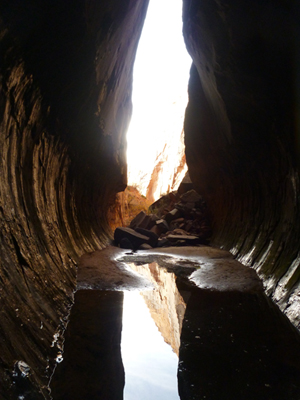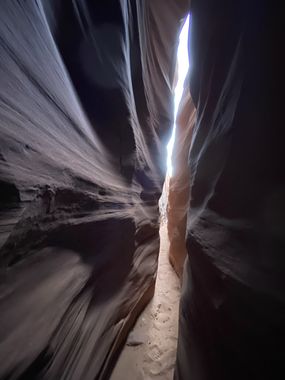Shenanigans
| Rating: | |||||||||||||||||||||||||||||||
|---|---|---|---|---|---|---|---|---|---|---|---|---|---|---|---|---|---|---|---|---|---|---|---|---|---|---|---|---|---|---|---|
| | Difficulty:3B III PG (v3a2 V) Raps:1-3, max ↨45ft
Red Tape:No permit required Shuttle:Optional Vehicle:Passenger Rock type:Sandstone | ||||||||||||||||||||||||||||||
| Location: | |||||||||||||||||||||||||||||||
| Condition Reports: | 26 Nov 2025
"Very long sustained narrows that twist and turn. Very fun and beautiful!. Approach from Middle Lep Vista without car shuttle: 1.5hr.. First la |
||||||||||||||||||||||||||||||
| Best season: | Spring; Fall
|
||||||||||||||||||||||||||||||
| Regions: | |||||||||||||||||||||||||||||||
Introduction[edit]
Shenanigans is a very narrow slot canyon. You should bring the smallest packs that you can and minimize your gear. There are four narrows sections, that progressively get narrower. Each section takes about 1 hour, except the 2nd narrows which is a bit shorter. There is only one early escape exit point, which is after the end of the 3rd narrows and before entering the 4th narrows. The 4th narrows is easy to identify by the "Grim Crawl" which presents itself at the beginning of this section and is a ledge on the right upon which one can crawl to avoid rappelling a 40 foot dryfall. Since the 4th narrows are noticeably more narrow, difficult, and claustrophobic than the 3rd narrows section, it is highly advisable to take the early exit if someone in the group has any doubts. Rescue out of this type of narrows is not practical. The early exit is on canyon left and is marked by a rockfall ramp. If navigated correctly, it is a Class 3 climb out. Once at the top, rim walk left back to the head of the canyon.
Warning: You should be skinny to go through this canyon. If you are claustrophobic, avoid this canyon. I am 6'0 165 lbs and the narrows were tight. At some point in the canyon, you will feel the fear creep in. We had to exhale the air from our lungs to get through some of the sections. You have to remain calm and support each other both mentally and physically in going through the narrows. It is good to provide space between each other so that you can help with getting the packs and gear through the narrows. You will not be able to rescue each other in the narrows. If you get stuck, it is going to be the most terrifying time in your life.
Approach[edit]
Instead of parking at the P in the above map, it is possible to drive another 1.0 mile to the actual head of the canyon. The drive is down a less maintained dirt road, which may have some deep sand, but is typically easy to go down. If driving up this sandy hill section is something you want to avoid, driving out can be done by continuing straight to the next dirt road, and then making a left. From the head of the canyon, at 38.06394, -110.48458, it is a 10 minute walk to the first drop, which involves a 10' sheer drop off a ledge, followed by a 25' dry flute. To avoid a nuisance rappel off this 10' ledge, rim walk 150' on the left to 38.06044, -110.48835 to an easy scramble down.
Descent[edit]
The 25' dry flute down-climb marks the beginning of the 1st section of narrows. If anyone does not want to downclimb the 25' dry flute, there is a convenient anchor on a small tree on the left. After about 20 minutes there is a pool at 38.0593, -110.49023, which is usually waist deep. The end of the first narrows is at 38.05666, -110.49196 where the walls on either side come down to head level. It is not possible to exit here. After a short walk, the 2nd narrows section is entered.
The 2nd narrows is slightly more constricting than the first, and involves some stemming but can mostly be walked on the bottom. It is about 1,000' long. A short walk in the open brings you to the 3rd narrows section. It is slightly more constricting than the 2nd section and will take approximately one hour to descend. The end of the 3rd section is at 38.05171, -110.49583 and is marked by a wide open wash with an exit possible on the left up a rock fall crack.
The 4th narrows section is the most constricting and most sustained. Even so, the tightest section, near the end, may only take about 15 minutes if it is done smoothly. At the beginning of the 4th section is the "Grim Crawl" that is a crawl on a wide ledge on the right used to avoid a 40 foot dryfall. Often times, the most skilled downclimber will act as a meat anchor, letting the rest of the group rappel down the dryfall. Then the person that acted as the meat anchor will go across the Grim Crawl and make the 40 foot downclimb. The 4th narrows can be divided into two parts. The first half one can stem high and move efficiently through almost all of it. The second half is hard to get on top of, as the walls are typically 10" - 14" wide and very hard to shimmy up. For skinny people, it is a fairly easy walk through although it does require going sideways most of the way. For larger frame people, it will require more finesse. Typically elevating a few inches or lowering a few inches is all it takes to find the sweet spot. A couple places may require going down onto a knee and elbow. A couple places may required elevating a few feet. Since the walls quickly reach 50' high, elevating all the way to the top would sap a tremendous amount of energy, which is better to conserve and find a hole near the bottom. The end of the 4th section is obvious where the canyon widens up enough to stem down to a chockstone where the anchor for the final rappel is. This is a 45' rappel. The pool at the bottom of the rappel can be avoided by walking a tiny ledge on the left and using thin cracks for finger holds.
The bottom of the canyon, end of the technical section is at 38.04668, -110.50125 and is barely 1.5 miles from the head. Although an experienced group may do the descent in as little as 3 hours, it could easily take 6 hours for less experienced groups and of course, much, much longer if someone gets stuck.
Rappels: The number of rappels are going to be between 3-4 depending on your down climbing ability. Most of the rappels have webbing, however, we used potshots as an anchor on one of the down climbs. The last rappel, you will have to navigate a pool. We did not carry a wet suit, however, it might be wise in cold conditions. The wet suit will add gear and create more problems with navigating the narrows.
Here is a picture of the pool (conditions can change):

(photo by Conrad Wentzel)
Narrows: The canyon will consist of four narrow sections. They will get tighter as you descend the canyon. The fourth will be the tightest section with ranges of 10-12 inches.
Here is a full video (15 min) of going through the fourth narrows:
OF NOTE - IF A RESCUE IS NEEDED
If one or more of your group members do need rescue, the following may be helpful. If the people in the party are unable to complete the 4th narrows they may be able to backtrack to the grim crawl. When the rest of the group continues through the canyons and comes back to the exit vehicle they can walk the canyon to 38.0514933, -110.4963178. At this location a cairn anchor may be set up to drop in one member of the party (100 feet) to complete the canyon up until the grim crawl. A meat anchor can be set up to aid the members of the party to ascend back up and upclimb the canyon to the drop in point. At that point, all members can ascend out of the canyon and escape. It goes without saying that it would be best if all members were small enough to get through so a rescue situation does not arise.
Exit[edit]
Refer to the Beta sites listed below. We descended down and completed Leprechaun canyon to our shuttle vehicle.
Red tape[edit]
Beta sites[edit]
 BluuGnome.com : Shenanigans Canyon
BluuGnome.com : Shenanigans Canyon RoadTripRyan.com : Shenanigans
RoadTripRyan.com : Shenanigans CanyoneeringUSA.com : Shenanigans
CanyoneeringUSA.com : Shenanigans Climb-Utah.com : Shenanigan - North Wash
Climb-Utah.com : Shenanigan - North Wash CanyonCollective.com : Shenanigans
CanyonCollective.com : Shenanigans Super Amazing Map : Shenanigans Slot
Super Amazing Map : Shenanigans Slot SummitPost.org : Shenanigans
SummitPost.org : Shenanigans
Trip reports and media[edit]
- Shenanigans, Tom Jones, March 2002
- Shenanigans, Mike Dallin, October 2003
- Ramfest '05, Todd Martin
- Freezefest '06, Tom Jones
- Freezefest '07, Dan Ransom
- Shenanigans, Dan Ransom, 2007
- Shenanigans, Mark Fallentine, April 2013
 Candition.com : Shenanigans Canyon
Candition.com : Shenanigans Canyon- Shenanigans, Bob Allan, September 2012
- Return to Shenanigans, Bob Allan, January 2017
- https://www.stavislost.com/hikes/trail/shenanigans-canyon
